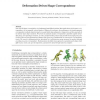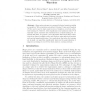CGF
2008
13 years 4 months ago
2008
Non-rigid 3D shape correspondence is a fundamental and difficult problem. Most applications which require a correspondence rely on manually selected markers. Without user assistan...
BMVC
2002
13 years 6 months ago
2002
Flexible Shape Models (FSMs), have been widely used for modelling shape variations of deformable objects [4]. A major limitation of this approach is that it assumes a near fronto-...
ICRA
1998
IEEE
13 years 8 months ago
1998
IEEE
Parts manufactured to tolerances have shape variations. Most work in robotic manipulation assumes that part shape does not vary. Orienting devices such as bowl feeders frequently ...
AMFG
2007
IEEE
13 years 10 months ago
2007
IEEE
In tracking face and facial actions of unknown people, it is essential to take into account two components of facial shape variations: shape variation between people and variation ...
MICCAI
2005
Springer
14 years 5 months ago
2005
Springer
Shape priors attempt to represent biological variations within a population. When variations are global, Principal Component Analysis (PCA) can be used to learn major modes of vari...
ICCV
2005
IEEE
14 years 6 months ago
2005
IEEE
In this paper, we address the issue of extracting contour of the object with a specific shape. A hierarchical graphical model is proposed to represent shape variations. A complex ...
CVPR
2007
IEEE
14 years 6 months ago
2007
IEEE
This paper proposes a novel model-guided segmentation framework utilizing a statistical surface wavelet model as a shape prior. In the model building process, a set of training sh...


